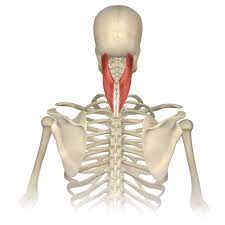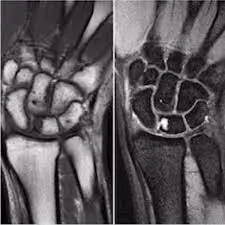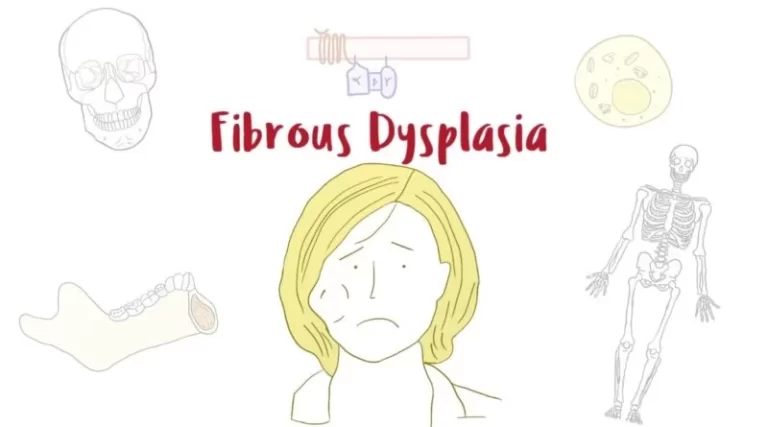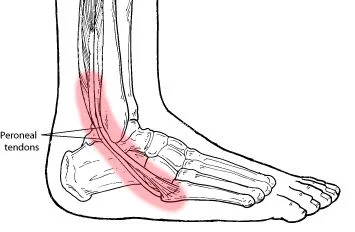Splenius Capitis Muscle Syndrome
Table of Contents
What is Splenius Capitis Muscle Syndrome?
- The splenius capitis is a large, broad muscle situated deeper within the back of the neck. The beginning of this flat, thick, and broad muscle begin at the vertebral column, especially from C-7 to T-3. It runs down the back of the neck. Its ending point is situated on the mastoid process of the temporal bone, the superior portion of the nuchal line, or the base of the occipital bone.
- This muscle is used for rotating the head from side to side or extending it upright position. These muscles are situated bilaterally, on either side of the neck. They work with each other for stabilization or movement of the head. The splenius capitis muscle also plays an important role in opening the lower jaw.
- The splenius capitis muscles might become strained during a traumatic neck injury or cause significant pain. 1st described in the 1980s, splenius capitis syndrome is a disorder condition with a designed pain pattern that makes it apparent, although it might sometimes be confused with tendonitis or migraine pain.
Anatomy of Splenius Capitis Muscle
- Splenius capitis is one of the deeper, and intrinsic muscles of the back of the neck. It is situated in the superficial layer, meaning that it is nearer to the aspect compared to the rest. The name arises from the Greek word ‘Splenion’ which stands for the bandage, or the Latin word ‘caput’ means head, hence it has bandage-like look.
Origin
- The badge-like splenius capitis starts from the lower half of the nuchal ligament or spinous processes of the 7th cervical to the 3rdthoracic vertebrae (C7 to T3).
Insertion
- The muscle fibers pass superiorly or laterally, in order to end in the mastoid process of the temporal bone. The mastoid process is a pyramidal-structure eminence on the base of the skull or is a pneumatised bone due to the mastoid air cells. The muscle also ends in part into the external surface of the occipital bone, under the lateral section of the superior nuchal line.
Nerve Supply
- The nerve supply to the muscle begins from the lateral branches of the posterior rami of the 2nd or 3rd cervical spinal nerves (C2 to C3).
Blood Supply
- The vascular supply to the muscle begins from the muscular branches of the occipital artery, a branch of the external carotid artery.
Action
- The Splenius capitis helps in supporting the head in a steady position.
- It Acts bilaterally: extension of the head or cervical spine
- It Acts unilaterally: lateral flexion of the head or neck or rotation of the head to the same side (when acting synergistically with sternocleidomastoid).
- The muscle tightens with mandibular protrusive motion or in the wide opening motion of the lower jaw.
- Synergists: splenius cervicis, semispinalis capitis, semispinalis cervicis, the upper portion of the trapezius.
The function of Splenius Capitis Muscle
- Bilateral contraction of splenius capitis ends in the extension of the head on the neck.
- When it squeezes unilaterally, it works in synergy with the opposite sternocleidomastoid muscle, resulting in lateral flexion or rotation of the head near the ipsilateral side.
- Therefore, splenius capitis work as a shaker of the head.
- Different muscles that extend or rotate the head include semispinalis capitis or semispinalis cervicis, which also bend the head laterally.
- The superior portion of the trapezius also works as a lateral flexor of the neck.
Causes of Splenius Capitis Muscle Syndrome
- Splenius capitis syndrome is a condition in which specifically the splenius capitis muscle is strained due to trauma and overuse of the muscle. The patient will develop severe pain because of tension that evolves in the area. Microtrauma might cause the affected muscle to swell-which is responsible for causing the pain.
- Some causes of splenius capitis syndrome consist of:
- Trauma to the neck and head
- Whiplash, particularly from a car accident
- The frequent posture that keeps the head downward
- Falls compromise the integrity of the neck alignment
- Football, wrestling, swimming
- Repetitive overuse in that muscle
Pain Pattern of Splenius Capitis Muscle Syndrome
- While whiplash is the most common cause of splenius capitis muscle syndrome, this condition might be caused by poor posture and an overuse injury as well. Slouching at a computer for long periods or sleeping without any neck support may strain the neck muscle. Lifting heavy weights in the gym without using any proper body mechanics or performing repetitive sports and activities, like swimming, might develop trauma to the area over time.
- Splenius Capitis Muscle Syndrome typically mimics the respective pain reference patterns of migraine headache or temporal tendinitis. The painful headache arises at the lateral side margin of the superior nuchal line or medial side to the mastoid process.
- The reference areas of pain pattern are given as follows:
- The rear of headaches or hurts.
- Lateral temple headache.
- Retro-orbital headache or pressure.
- Aching pain above the eye.
- Aching pain in the cheekbone below the eye.
- The eye hurts or is sensitive to bright light.
- Pain radiates to the neck, shoulder, or arm at times.
- Nausea or vomiting when pain is intense.
Symptoms of Splenius Capitis Muscle Syndrome
- The primary symptoms linked to splenius capitis syndrome revolve around the pain situated with the inflammation developed by microtrauma to the muscle. Sometimes, this syndrome is confused with migraine headaches and tendonitis. Patients should always consult a doctor if they feel severe headaches.
- Splenius capitis Muscle symptoms consist of:
- Sensitivity to light
- Severe head pain
- Nausea or vomiting
- The pain situated with splenius capitis syndrome causes an aching headache with marked photosensitivity and sensitivity to the light. The back of the head will hurt, together with the temporal area. Splenius capitis pain will radiate, and travel, towards the neck, shoulder, or arms. Aching will occur surrounding the eye as well, centering above the eye or the cheekbone. At times, the pain can develop into nausea or vomiting.
Diagnosis of Splenius Capitis Muscle Syndrome
- The more effective way to confirm the diagnosis of Splenius Capitis Muscle Syndrome is to apply digital pressure at the superior nuchal line between the trapezius or the sternocleidomastoid muscles at nuchal line.
- If the area is painful and stimulates the pain referral pattern, then the source of the headache or pain might have been located. Next, inject 1cc of a non-vasoconstrictor local anesthetic into the painful insertion zone, 1st aspirating to assure that the needle tip is not in a vessel. Then gently inject 0.8 ccs local anesthetic.
- Within 1 min the pain pattern should be remitted if the diagnosis is correct or if there are no other concurrent pain disorders present. With the pain remitted, inject a 1/8 to 1/4 cc of cortisone into that area. Hopefully, the pain will not be back.
- However, if it does, repeat the process 2 or 3 times. This will help to clarify if the insertion fibers are damaged or might require radiofrequency thermoneurolysis (RFTN) to “turn off” the terminal sensory nerve end organs.
- If radiofrequency thermoneurolysis is suggested, an RFTN unit, such as the Owl RF Generator Model URF-2AP (Canadian Medical Devices, Toronto, Canada), is utilized. A typical technique is to create 3 RFTN heat lesions on a horizontal axis to try to assure “coverage” of the deformed insertion fibers. Before to lesioning, use the stimulus mode of the RF Generator to assure the probe tip is not on an unexpected sensory and motor branch nerve. The RFTN should not generate any sensory deficit at the scalp since the local anesthetic block did not do that so.
Treatment of Splenius Capitis Muscle Syndrome
- As with treatment for numerous forms of orofacial pain, treatment is relay on the cause of the pain or might involve clinical or surgical techniques as well as behavioral and stress-relieving methods.
- Stretching and Strengthening the splenius capitis muscle can be useful for releasing tension from the muscles and making it more strongly for reoccurring pain in the muscle.
- Clinical treatment of Splenius Capitis Muscle Syndrome includes injections of anesthesia into the affected muscular area. Minimally-invasive surgical procedures might be used to permanently decrease nerve function within the muscle.
- Splenius capitis treatment plan should be prescribed by a licensed professional after a proper evaluation. They will evaluate the patient on a case-by-case basis to generate a patient-centered treatment plan based on the chronicity of the syndrome.
- The healthcare provider might prescribe a series of stretches to help alleviate the tension or swelling. Medications can also be used for alleviating the pain. In other cases, radiofrequency thermoneurolysis might be recommended. Splenius capitis syndrome can be resolved with an individualized treatment plan created with proper care.
Stretching Exercise for Splenius Capitis Muscle Syndrome
Splenius capitis muscle stretch
- The left-side splenius capitis is stretched by flexing, right laterally flexing, and right rotating the head and neck at the spinal joints, while the left-the-side shoulder girdle is allowed to elevate.
- You can hold for 30 seconds and 3 repetitions.
Sitting capitis muscle stretch
- Stand or sit upright
- Keep your head up facing straight ahead
- Push your head forward side by sticking out your chin
- Note: Keep your head up during this stretch. Do not let your chin fall towards the floor.
- You can hold for 30 seconds and 3 repetitions.
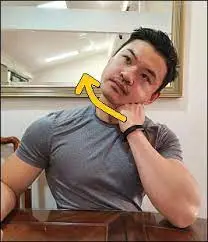
Table Splenius Stretch
- Sitting in front of a table.
- Keep the chin in & down throughout this stretch.
- Place the left fist on the left side of the chin.
- Place the left elbow onto the table in front of you.
- Rest the weight of the head onto your fist.
- Tilt the head to the left.
- Apply more pressure to the chin to gear up the stretch.
- The goal is to feel a firm stretch on the right side of the neck.
- Hold for 30 secs.
- Perform on the alternate side.
Basic Splenius Stretch
- Tuck the chin in & downwards.
- Tilt the head to the right.
- Put the right hand on the opposite side of the head.
- Apply downward compression.
- Slowly turn the head to the left.
- The goal is to feel a firm stretch in the left Splenius Capitis Muscle.
- Hold for 30 secs, 3 rep.
- Repeat on the alternate side.
Splenius Stretch Variation
- Place the fingers on top of the left collarbone.
- Pulling the skin down.
- Tuck the chin in & down.
- Slowly turn the head towards the left side.
- Tilt the head towards the right.
- The goal is to feel a stretch on the left Splenius Capitis Muscle.
- Hold for 30 secs, 3 rep.
- Repeat on the alternate side.
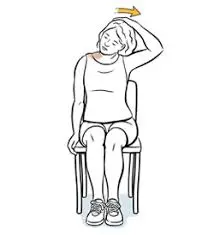
Chair Lean Stretch
- Sitting down on a chair.
- Using the right hand, grab onto the side of the chair.
- Keep the shoulder completely relaxed.
- Lean the body completely towards the left.
- Tuck the chin in & downwards.
- Tilt the head towards the left.
- Place the left hand on the right side of the head
- Apply downward compression.
- The goal is to feel a stretch on the right Splenius Capitis Muscle.
- Hold for 30 secs, 3 rep.
- Repeat on the alternate side.
Neck Elongation Stretch
- Tuck the chin in & downwards.
- Slide the head towards the right side.
- Elongate the right side of the neck in an upwards direction.
- The goal is to feel a stretch on the right side of the neck.
- Repeat on the alternate sides.
- Perform 30 reps, 3 reps.
Strengthening Exercise For Splenius Capitis Muscle Syndrome
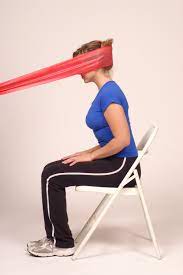
Theraban Rows
- First Place the theraband around a doorknob & tie a knot in the theraband & close it in the door.
- The band is at chest level.
- You are standing tall with each end of Theraband in your hands & knee joint slightly bent, abdominal muscles tight.
- Must be Maintained tight trunk muscles & pull arms back while squeezing the shoulder blades together.
- You are trying to focus on squeezing the shoulder blades without shrugging the shoulder joint up towards the ears.
- Then return to starting position but Do not lean back.
- Hold this exercise position for 10 seconds.
- Perform the 10 times in 1 session & 3 sessions per day.
Head lifts
- You are Lie flat on the back with the arms stretched to the sides.
- Nod the head & tuck in the chin.
- Hold this exercise for a few seconds before releasing back to a neutral position.
- Hold this exercise position for 10 seconds.
- Perform the 10 times in 1 session & 3 sessions per day.
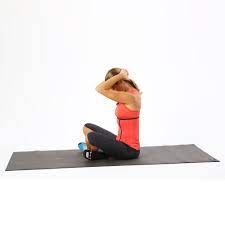
Seated Clasped Neck Stretch
- You are sitting comfortably on the floor & in a chair.
- Must place your body in proper alignment.
- Then Clasp your hands & bring both palms to the back of your head.
- Try to Gently press your hands down toward your thighs & tucking your chin into your chest.
- Hold this stretching position for 30 seconds.
- Perform the 3 times in 1 session & 3 sessions per day.
Chin tuck Exercise

- Sitting straight & look straight ahead with the ears parallel over the shoulders.
- Put two to three fingers on the chin.
- Stabilize the finger, pull the chin & head straight behind up to a gentle stretch felt at the base of the head & top of the neck.
- Hold for 5 to 10 secs. Repeat seven to ten times.
Neck flexion Exercise (Neck tilt)
- In Relax sitting position flex the head down to rest the chin on the chest (Flex the neck fully).
- Gently tense the neck muscles & hold for 4 to 8 secs.
- Return to the initial position & repeat seven to ten times.
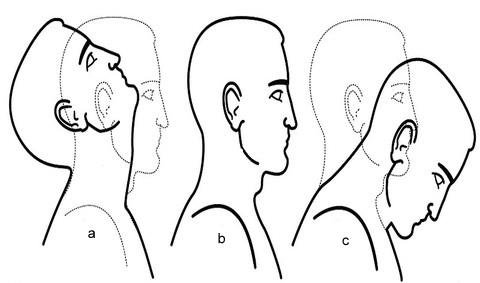
Neck extension exercise
- In Relax sitting position without arching the back, slowly move the head backward so you are looking upward.
- Hold for 5 to 10 secs. Return to starting position.
- This is a good exercise to do during working hours to prevent neck strain.
- Gently tense the neck muscles & hold for 5 to 10 secs.
- Return to a neutral position & repeat 10 times.
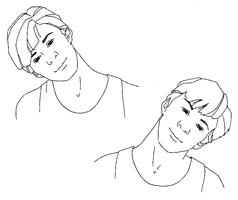
Neck flexion Exercise (side to side)
- Flex the head down towards the shoulder, & try to touch the shoulder with the ear (Without elevating the shoulder).
- Gently tense the neck muscles & hold for 8 secs.
- Return the head to a neutral position & repeat in the opposite direction.
- Repeat 10 times on both sides.
Neck Rotation exercise
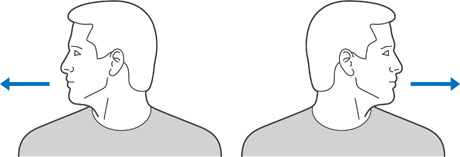
- Rotate the head towards one side, keeping the chin at the same height & moving within comfortable limits.
- Gently stretch the neck muscles & hold for 8 secs.
- Return the head to the neutral position & repeat in the opposite direction.
- Repeat 10 times each on both sides.
Revolved Triangle Exercise
- Stand with the feet about four feet apart.
- Face the right toes forward & the left toes out at a slight angle.
- Square the hips & face forward in the same direction the right toes are pointing.
- Lift the arms up at the sides so they are parallel to the floor.
- Slowly hinge at the hips to fold forward, stopping when the torso is parallel to the floor.
- Bring the left hand to the leg, the floor, or a block, wherever you can reach.
- Extend the right arm straight up with the palm facing away from the body.
- Turn the gaze to look up toward the right thumb.
- Exhale to turn the neck to look down at the floor.
- Inhale as you return the gaze upward.
- Keep the rest of the body stable & continue these neck rotations as you stay in the pose for up to one min.
- Perform on the alternate side.
Upward Plank Exercise
- This pose allows you to passively hang the head back & down, releasing tension in the neck & shoulders. This lengthens & stretches the Splenius Muscle, SCM, chest, & shoulder muscles.
- Make sure the back of the neck is fully relaxed to avoid compressing the spine. If it is uncomfortable for you to let the head hang back, you can tuck the chin into the chest & lengthen the back of the neck. Precise on engaging the neck muscles without straining.
- You can also allow the head to rest back on some type of support such as a chair, a wall, or stacked blocks.
- How to do- Come into a seated position with the legs straight in front of you.
- Press the palms to the floor alongside the hips.
- Lift the hips & bring the feet under the knees.
- Deepen the pose by straightening the legs.
- Open the chest and & let the head drop back.
- Hold for up to 30 secs.
- Do this pose up to three times.
Prone Cobra Exercise
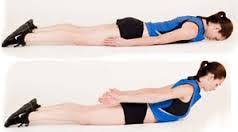
- This exercise is done by lying face downwards on the ground & uses gravity as resistance in the reinforcing process.
- Lying face downwards on the floor, put the forehead on a rolled-up hand towel for comfort.
- Place the arms by the side, and palms downwards on the ground.
- Touch the tongue on the upper palate of the mouth.
- Pinch the shoulder blades together & raising the hands off the ground.
- Roll the elbows inwards, palms outwards, & thumbs upwards.
- Gently raise the forehead about an inch off the towel keeping the eyes looking straight forward at the ground
- Hold the position for 7 to10 secs.
- Do10 repetitions.
Isometric Neck Exercise
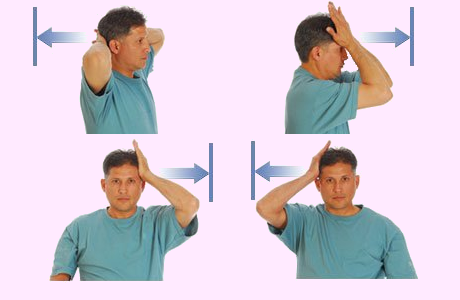
- Isometric neck exercise helps to strengthen the neck muscles. This exercise is mostly recommended by Physiotherapists from day 1st to relieve Neck pain.
Isometric Neck Exercise
How to perform this exercise In a sitting Position, - keep the Body straight, Put both hands behind the neck (as seen in the images), & try the neck to push pressure on the hands & At the same time Resist the neck muscles, both hands maintain align position for 4 to 5 secs & then relax.
The first day does 8 repetitions & the second day does 10 repetitions. Do some exercise on the forehead & each side of the neck.
Do the exercise by pressing on the side of the head. Repeat 8 times, then alter sides.
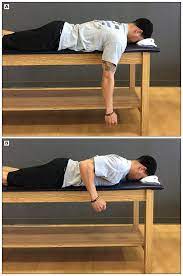
Prone Rows Exercise
- Lie on the stomach with the arms dangling off the side of the bed (try angling the body so the head is facing the corner of the bed).
- Use a pillow under the stomach for comfort. Begin by pulling arms back while bending elbows & squeezing shoulder blades together then slowly return to the initial position.
- Do not lift the head up while pulling the arms back.
- Repeat 20 times. Perform 2 times a day.
Standing pushups exercise
- Stand about an arms-length down from the wall with the bases spread piecemeal.
- Place the hands on the wall, making sure that they parallel with the shoulders.
- Keeping the reverse straight, sluggishly bend or flex the elbows, bringing the upper body toward the wall.
- Unbend or extend the elbows & return to the starting position.
- Repeat 20 times. Perform 2 times a day.

Lateral extension exercise
- Start by looking straight ahead. Slowly lean the head to the left side. Use the left hand for resistance, use the muscles in the neck to press against it. Hold for 5 to 10 secs, then return to the initial position.
- Then, slowly lean the head to the alternate side. Hold for 5 to 10 secs.
- Return to the initial position. Do 10 repetitions. This is a good exercise to do while in working hours, especially if you have to keep the head in a steady position for prolonged periods, as in working at a computer. Do this exercise every half hour to prevent neck strain.

Tilted forward flexion exercise
- Sluggishly lean the head to the leftism. Using the left hand for resistance, use the muscles in the neck to press against it. Hold for 5 to 10 secs, and also return to starting position.
- Also, sluggishly lean the head to the other side. Hold for 5 to 10 secs.
- Return to starting position. Do 10 repetitions. This is a good exercise to do during work, especially if you have to keep the head in a steady position for a prolonged time as in working at a computer. Do this exercise every partial hour to help with the prevention of neck tightening.
FAQs
What Causes Splenius Capitis Muscle Syndrome?
Splenius capitis syndrome is a condition in which specifically the splenius capitis muscle is strained due to trauma and overuse of the muscle. The patient will develop severe pain because of tension that evolves in the area. Microtrauma might cause the affected muscle to swell-which is responsible for causing the pain.
What are the Symptoms of Splenius Capitis Muscle Syndrome?
The pain situated with splenius capitis syndrome causes an aching headache with marked photosensitivity and sensitivity to the light. The back of the head will hurt, together with the temporal area. Splenius capitis pain will radiate, and travel, towards the neck, shoulder, or arms. Aching will occur surrounding the eye as well, centering above the eye or the cheekbone. At times, the pain can develop into nausea or vomiting.
How will you Identify Pain Patterns of Splenius Capitis Muscle Syndrome?
Splenius Capitis Muscle Syndrome typically mimics the respective pain reference patterns of migraine headache or temporal tendinitis. The painful headache arises at the lateral side margin of the superior nuchal line or medial side to the mastoid process.
The reference areas of pain pattern are given as follows:
The rear of headaches or hurts.
Lateral temple headache.
Retro-orbital headache or pressure.
Aching pain above the eye.
Aching pain in the cheekbone below the eye.
The eye hurts or is sensitive to bright light.
Pain radiates to the neck, shoulder, or arm at times.
Nausea or vomiting when pain is intense.What are the Treatments for Splenius Capitis Muscle Syndrome?
Treatment is relay on the cause of the pain or might involve clinical or surgical techniques as well as behavioral and stress-relieving methods.
Clinical treatment of splenius capitis muscle syndrome involves injecting local anesthesia into the affected area of the muscle.
Stretching and Strengthening the splenius capitis muscle can be useful for releasing tension from the muscles and making it more strongly for reoccurring pain in the muscle.How Will You Relax Your Splenius Muscle?
By doing stretching to the splenius capitis muscle an individual can relax their splenius muscle.
The left-side splenius capitis is stretched by flexing, right laterally flexing, and right rotating the head and neck at the spinal joints, while the left-the-side shoulder girdle is allowed to elevate.
You can hold for 30 seconds and 3 repetitions.

